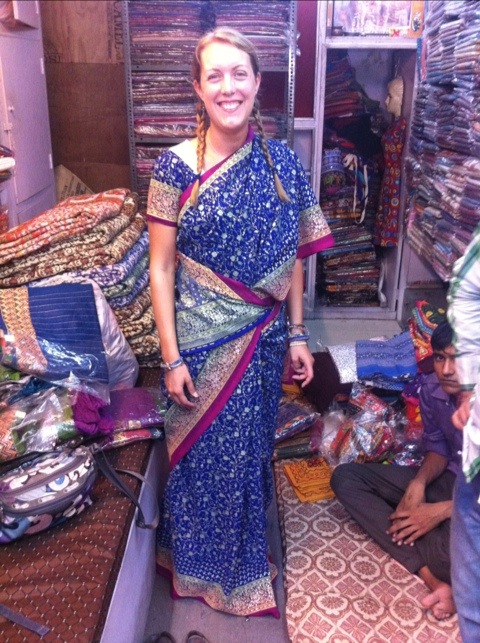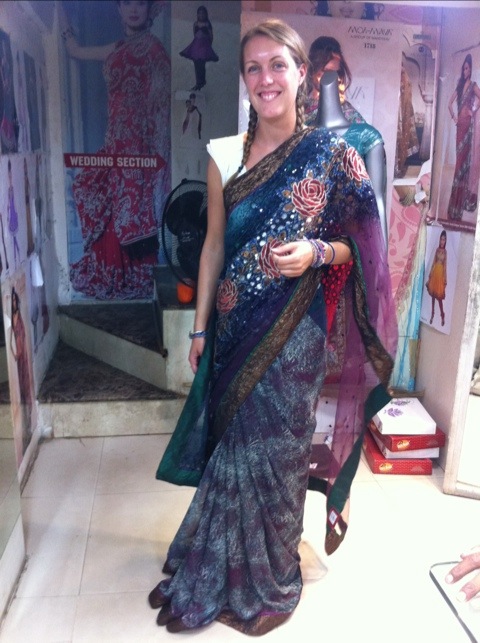The feeling of excitement and optimism vibrating in the air with the build up to Diwali intoxicated and seduced me, finally making the allure of a beautifully colourful sari too much to resist.
With the main celebrations only a day away I threw myself into the unknown world of sari shopping with gusto! With absolutely no idea what we were doing Simon (who was very patient and helpful, and could probably now offer you some good advice on Indian textiles) and I allowed ourselves to be led into one of the hundreds of sari shops in the bazaars of Jaipur. Following the shop keeper upstairs we found ourselves surrounded by shelves of sparkling fabrics of every imaginable colour. With no notion of desired fabric or design we began with the only criteria I had decided on: colour, it must be bright blue (or maybe purple)! When shopping in the bazaars sari sellers will inevitably begin showing you the most expensive fabrics first, working our way down from intricately embroidered yards of silk to the polyester/silk blends and finally cotton. We ended up surrounded by mounds of material with a vague idea of what one may be able to purchase for 1000 rupees (about £13). We thanked the shop keeper, making vague promises to return and accepting his business card stepped out of the door.
We repeated this process at a range of establishments until we felt well versed in the variety of saris available and how much they could be bought for. A sari that you are being quoted “final price” 1000 rupees for inside can become a desperate “ok, 400 rupees!” as you walk out the door.
At around the 5000 rupee mark you can acquire a stunningly decorated pure silk, crepe or net sari with beautifully embroidered borders, ornamented with sequins, beads and appliqué flowers. For 1000-2000 rupees you can purchase a range of saris in silk, chiffon, or georgette (a silk and rayon blend) with some lovely embroidery although obviously lacking the detail of the more expensive saris. For under 1000 rupees (you do have to bargain) you can still choose from a beautiful selection of patterned polyester silk, block or hand printed georgette or rayon, and vibrant tie-dyed and printed cotton cloths (the cheapest option – you could probably beat the price down to around 200 rupees). Of course more elaborate and expensive saris can run into the hundreds of thousands of rupees, and the more you pay the better the quality should be, however I was happy to compromise on quality for cost!
For the novice sari wearer a sari is a length of fabric around 6 m long and 1 m wide that is wrapped once around the waist, then folded in a concertina fashion to form pleats at the front of the skirt, before continuing around the upper body and draping the final length (the palloo) over the shoulder. The skirt of the sari it typically tucked into a drawstring petticoat, whilst a cropped, fitted blouse (a choli) is worn under the top part. Most saris come with enough extra fabric for the blouse to be cut from (it may be worth asking before buying), alternatively you may be able to purchase some complimentary fabric to have a blouse fashioned from or even possibly buy a pre-made blouse.
Having successfully chosen your sari you will need to take it to a tailors to get the blouse made up and the sari hemmed. The shop keeper will probably be able to recommend a tailor and give you an indication of price and how long it should take. Wanting my sari for the next day I didn’t have time to shop around for a tailor so I went through the shop who guaranteed to have it ready in three hours. It’s worth bearing the tailoring costs in mind (my sari cost 500 rupees and the tailoring an additional 550 rupees) when haggling for the fabric. As an inexperienced sari wearer I opted to have my sari made “ready to wear” meaning that the tailor sewed the skirt complete with pleats and lining so there is no need for me to deal with the intricacies of folding and tucking (and inevitable unravelling…).
The thing to remember when buying a sari is not to get carried away, if like me you just want something beautiful to wear a few times and to remember your time in India by you really don’t need to spend more than a few hundred rupees. Take your time to explore the different colours, textures and designs before settling on one, remember to haggle and don’t feel pressured to buy something just because they offer you an amazing price as you walk away, buy the sari you want and enjoy it!
Laura



Great choice Laura! The blue looks gorgeous on you. Now for an outfit for Simon…..